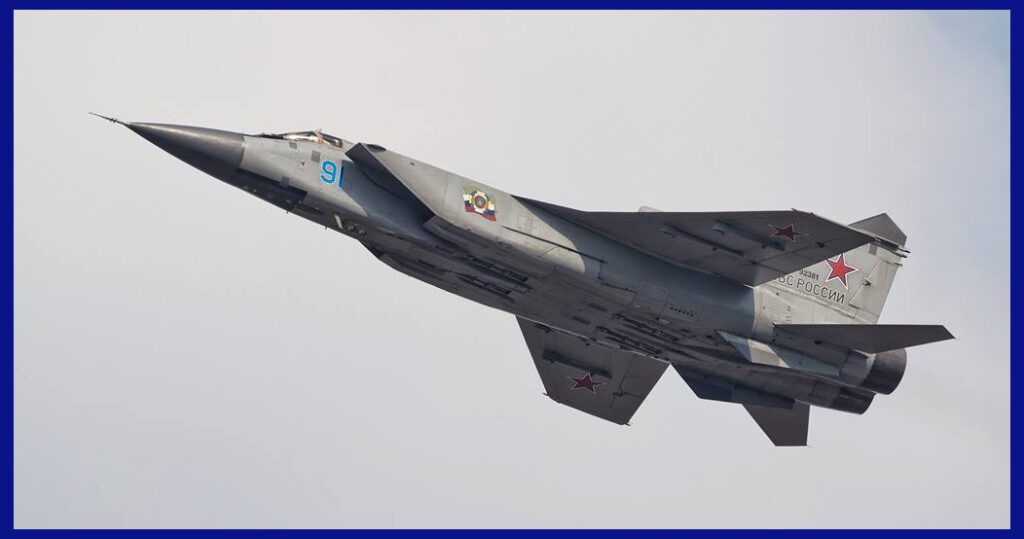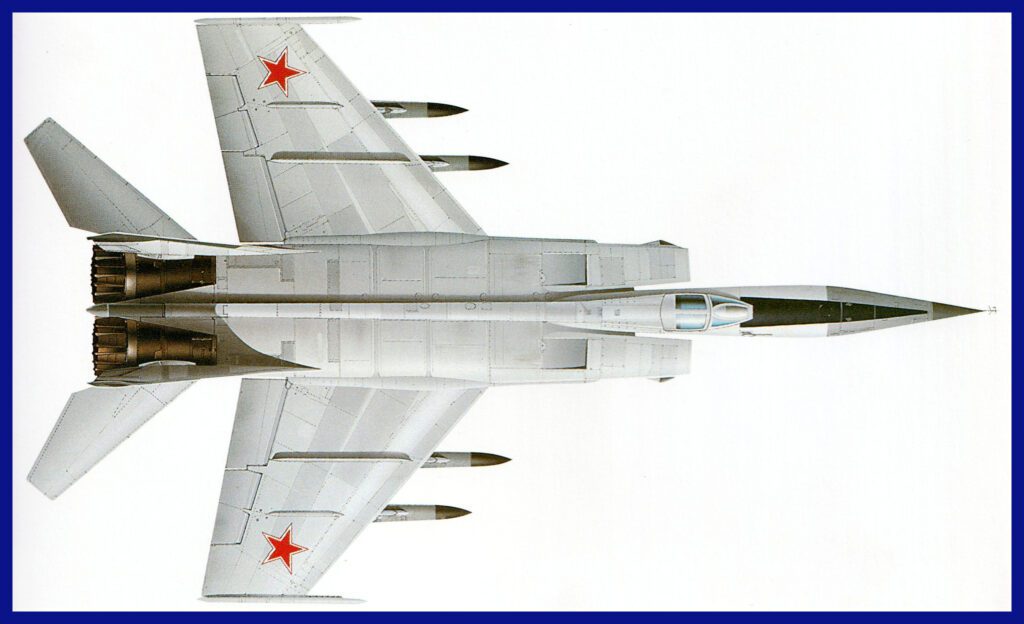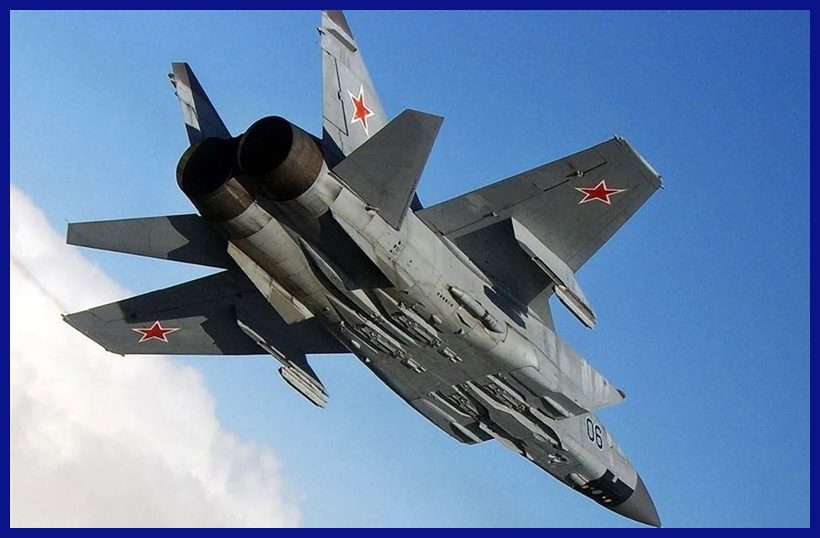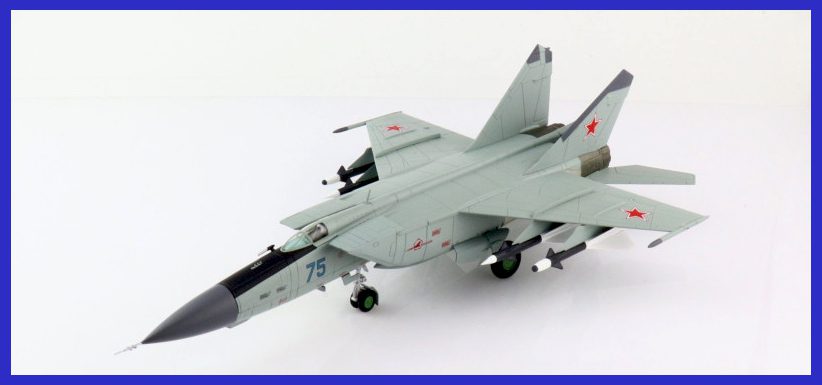Embark on a thrilling expedition through the boundless skies to unveil the remarkable realm of aviation. Let’s Explore The Russian High-Speed MiG-25 And MiG-31 and discover the thrill of pushing the limits of what’s possible. These aircraft are not just machines but a testament to the human spirit of innovation and exploration. As we delve deeper into their design and capabilities, we begin to understand the sheer magnitude of their power and beauty.
With their rugged designs and advanced engineering, these aircraft have proven their worth as formidable weapons of war, capable of flying at incredible speeds and altitudes.

The MiG-25 designated the Foxbat in NATO reporting, stood as a supersonic interceptor and reconnaissance aircraft meticulously crafted by the Mikoyan-Gurevich bureau within the Soviet Union. Its genesis emerged from the imperative to counter the United States high-altitude reconnaissance planes, compelling the Soviets to engineer an aircraft proficient in interception and engagement. With the passage of time, the aircraft also found its niche in ground attack and air-to-air roles, proving its versatility. Debuting in the 1970s, the MiG-25 surged forth as a pinnacle of swiftness during its era, boasting the capability to achieve velocities exceeding Mach 3.
The MiG-31, referred to as the Foxhound by NATO, stands as a supersonic interceptor aircraft meticulously developed by the Mikoyan design bureau to succeed its predecessor, the MiG-25. Its conception aimed at delivering heightened performance, particularly in the realms of speed and altitude, coupled with enhanced avionics and weaponry systems. Debuting in the early 1980s, the MiG-31 remains an active constituent of the Russian Air Force to this day, fulfilling an array of roles encompassing air defence, interception, reconnaissance, and even serving as a platform for anti-satellite weapons testing.

The MiG-25 Foxbat Design and Development Phase
In the era of the Cold War, the Soviet Air Defence Forces were entrusted with the pivotal role of safeguarding strategic airspace for the USSR. This encompassed not only addressing inadvertent border breaches but also, of paramount significance, fortifying the extensive expanse of Soviet airspace against United States reconnaissance planes and strategic bombers transporting unguided nuclear munitions.
During the latter part of the 1950s, the extensive high-altitude reconnaissance flights over Soviet territory by the Lockheed U-2 aircraft underscored the necessity for an even higher altitude-capable interceptor aircraft beyond the prevailing options. Coincidentally, this marked the juncture at which the USSR was compelled to conceive and engineer a robust, exceptionally swift interceptor to surmount this very obstacle, leading to the birth of the MiG-25.
In 1964, the inaugural prototype of the MiG-25 took to the skies, subsequently becoming operational in 1970. Boasting a peak operational speed of Mach 2.83, the aircraft’s propulsive force possessed the capability to push it beyond Mach 3.2. However, this remarkable velocity was deliberately constrained to avert the risk of engine overheating at elevated airspeeds, which could lead to irrevocable damage. The MiG-25 is distinguished by its formidable radar prowess and an armament of four air-to-air missiles, its altitude ceiling theoretically extending up to 27 km (89,000 ft).
The production of the MiG-25 series culminated in 1984, having seen the assembly of a total of 1,186 aircraft. Serving as an emblematic figure of the Cold War era, the MiG-25 found its wings not only under Soviet command but also within the fleets of Soviet-affiliated nations and former republics. This enduring legacy persisted through limited service with a handful of export clients.
Elevating itself to remarkable heights, the MiG-25 stands as one of the loftiest military aircraft to grace the skies. Distinguished by its rapidity, it secures a notable rank as one of the swiftly manufactured interceptor planes, second only to the SR-71 reconnaissance aircraft—a rarity in comparison due to its limited production. As of 2018, the MiG-25 stands unparalleled as the fastest human-piloted serially produced aircraft in active deployment, asserting its supremacy as the premier choice for supersonic and edge-of-space voyages, captivating civilian enthusiasts.

Some Additional Facts about the MiG-25 Foxbat
The development of the MiG-25 was kept highly classified, and the plane was shrouded in mystery for many years. When it first appeared in the skies over the Middle East in the 1970s, it was nicknamed the “Foxbat” by NATO pilots who had never seen anything like it before.
The MiG-25 was designed to intercept high-flying U.S. spy planes like the U-2 and the SR-71. To achieve this, it was built with a unique combination of speed, altitude, and range capabilities.
The MiG-25’s engines were so powerful that they required a special fuel mixture to operate, which was composed of 70% kerosene and 30% benzene. This fuel mixture was highly volatile and required strict handling procedures.
The MiG-25 set several world records during its time in service, including the altitude record for a jet-powered aircraft (37,650 meters or 123,523 feet) and the speed record for a climb to altitude ( 29,000 meters or 95,000 feet in just over 3 minutes ).
The MiG-25 was involved in several high-profile incidents during its service, including the defection of Soviet pilot Viktor Belenko to Japan in 1976. Belenko flew his MiG-25 to Japan and provided valuable intelligence to the U.S. about the plane’s capabilities.
This incident was considered a major security breach by the Soviet Union, and they subsequently halted further production of the MiG-25. Despite its impressive speed and altitude capabilities, the MiG-25 was not a very manoeuvrable plane and was vulnerable to more modern air defence systems. As a result, it was gradually phased out of service in the 1990s and replaced by more advanced planes like the MiG-31.

Nations that Have Utilized the MiG-25 Foxbat
Apart from Russia, there were a total of 12 countries that used this fast-flying aircraft, including India!
The Indian Air Force ( IAF ) did operate a small number of MiG-25RB Foxbat aircraft, which were acquired in the 1980s ( Took delivery of six MiG-25RBKs and two MiG-25RUs in 1981 ). The primary role of the MiG-25RB in the IAF was as a reconnaissance aircraft, and they were used for aerial reconnaissance missions along India’s northern borders with China and Pakistan.
The IAF’s MiG-25RB fleet was based at the Bareilly Air Force Station in Uttar Pradesh and was operated by No. 102 Squadron, which was nicknamed “Trisonics”. However, the MiG-25s were retired from service by the IAF in 2006, after more than two decades of secret service. However, It should be noted that the MiG-25RB was not a very popular aircraft in the IAF, due to its limited capabilities and high maintenance requirements.
Yet, the privilege of piloting this formidable aircraft fell to only a select handful of aviators. The sentiments are poignantly echoed by Wing Commander Sanjeev Taliyan of the Indian Air Force: “From the altitude we attain, the complete expanse of the Himalayan range unfolds before our eyes in a singular panoramic vista. The Foxbat has bestowed upon us a vantage point unparalleled by any other aircraft.”

The MiG-25 Foxbat Technical Specifications
- Pilot: 1
- Length: 78 ft 2 in ( 23.82 m )
- Wingspan: 46 ft ( 14.02 m )
- Height: 20 ft ( 6.1 m )
- Empty Weight: 20,000 kg ( 44,092 lb )
- Max Takeoff Weight: 36,720 kg ( 80,952 lb ) with four R-40 ( AA-6 ) Air-to-air missile
- Payload: 4,000 kg ( 8,818 lb )
- Hardpoints: 4
- Powerplant: 2 × Tumansky R-15BD-300 afterburning turbojet engines, 73.5 kN ( 16,500 lb ) thrust each dry, and 109.83 kN ( 24,691 lb ) with afterburner
- Max Speed: Mach 2.83 ( 3,000 km/h ) and ( 1,300 km/h ) at Sea level
- Combat range: 1,860 km (1,160 miles ) at Mach 0.9 Subsonic speed and 1,630 km ( 1,013 miles ) at Mach 2.35 supersonic speed
- Ferry range: 2,575 km ( 1,600 miles ) with endurance of 2 hours 5 min
- Service ceiling: 20,700 m ( 67,900 ft ) with four missiles
- Rate Of Climb: 208 m/s ( 40,945 ft/min )
- g limits: +4.5 supersonic
- Armament: On its four total hardpoints, it was specifically designed to carry AAMs such as the R-40 ( AA-6 Acrid ) and R-60 ( AA-8 Aphid )

The MiG-31 Foxhound Design and Development Phase
The MiG-31 is a replacement for the older MiG-25 “Foxbat” that was designed by the Mikoyan design bureau. It is based on and shares design cues with the MiG-25. The MiG-31 is one of the world’s swiftest combat aircraft. After the Cold War ended and the Soviet Union fell apart in 1991, it is still run by the Russian and Kazakh Air Forces. The MiG-31 is expected to stay in service until 2030 or later, according to the Russian Defense Ministry, which reaffirmed this in 2020 when it was announced that the service lifetime of the current airframes would be increased from 2,500 to 3,500 hours.
The MiG-25 was a powerful plane, but the team that designed it wanted to create something even better. They started working on the MiG-31, and the first version was tested in 1975. It may have looked similar to the MiG-25, but the MiG-31 was a new design that was built with a longer fuselage to fit a radar operator’s cockpit. One of the most impressive features of the MiG-31 was its advanced radar system, which could track multiple targets and shoot down low-flying planes and missiles from both above and below.
This was a big deal because it gave the Soviet Union an advantage over its Western enemies. The MiG-31 was used to replace an older plane called the Tu-128, and it was far superior because it had better sensors and weapons. It could also fly much farther than the MiG-25, almost twice as far in fact!
The Production Phase of MiG-31 Foxhound
After successfully testing the MiG-31, it went into full production in 1979. The first batch of planes included a whopping 519 units, with 349 being “baseline models.” These were built at the Sokol plant from 1976 to 1988. A second batch of 101 planes, called the MiG-31DZs, was produced from 1989 to 1991. The final batch of 69 planes, called the MiG-31B, was produced between 1990 and 1994.
After the Soviet Union was dissolved, the Kazakhstan Air Force held onto 50 of these planes. Out of the baseline models, 40 were upgraded to the MiG-31BS standard. It’s worth noting that the MiG-31 was a big deal in its day, and it was produced for nearly two decades until 1994 when production ended.

The Design Phase of MiG-31 Foxhound
The design of the MiG-31 was based on its predecessor, the MiG-25, but with significant improvements. One of the most notable changes was the addition of a second cockpit, which allowed for a dedicated radar operator to assist the pilot. This extra space added to the overall length of the aircraft, which gave it a sleek, streamlined look.
Although the MiG-31 was based on the design of the MiG-25, it had several key differences in wing design. The MiG-31 had a larger wingspan and more swept-back wings than the MiG-25. This gave it better stability at high speeds and improved manoeuvrability.
The wings of the MiG-31 were also equipped with leading-edge extensions, or LERX, which helped to improve airflow over the wing and increase lift. This allowed the aircraft to maintain stable flight at low speeds, reduced drag and high angles of attack, which was important for intercepting low-flying targets.
The MiG-31 also had a more advanced avionics system than the MiG-25, including a powerful radar that could track multiple targets simultaneously. This radar could detect and engage targets both above and below the aircraft, making it a formidable interceptor against low-flying cruise missiles and bombers. The MiG-31 has eight hard points ( 4 underwing pylons and four semi-recessed under the fuselage ) for carrying air-to-air missiles.
In terms of performance, the MiG-31 was one of the fastest aircraft of its time, capable of reaching speeds of up to Mach 2.83. It had a maximum range of around 1,450 miles and could operate at altitudes of up to 66,000 feet. This made it an ideal long-range interceptor for the Soviet Union during the Cold War.
Overall, the design of the MiG-31 was a significant improvement over its predecessor, with advanced avionics, an additional cockpit, and improved performance that made it one of the most capable interceptors of its time.

Advanced Cockpit Design of MiG-31 Foxhound
This aircraft adopts a two-seater configuration, wherein the occupant of the rear seat assumes control of the radar operations. Despite the replication of cockpit controls in both seating positions, the conventional practice involves flying the aircraft solely from the front seat. Piloting is executed through a central control stick and left-hand throttles. In the rear cockpit, the canopy is equipped with a mere two diminutive vision ports located on either side.
The incorporation of a WSO (Weapon Systems Operator) within the rear cockpit significantly enhances the aircraft’s operational prowess. The WSO is exclusively tasked with radar operations and weapons deployment, thereby alleviating the pilot’s responsibilities and elevating overall efficiency. Equipped with zero/zero ejection seats, both cockpits empower the crew to execute ejections at any altitude and airspeed, reinforcing safety measures.
Pioneering a significant breakthrough, the MiG-31 secured its distinction as the world’s inaugural operational fighter to employ the Zaslon S-800 passive electronically scanned array (PESA) radar. This cutting-edge radar system exhibits the capability to track up to ten targets concurrently, enabling the engagement of four of these with its Vympel R-37 missiles. In terms of fighter-sized targets, its effective range extends to approximately 200 km (120 mi). The aircraft’s innovative design further incorporates an infrared search and track (IRST) device nestled within a retractable under-nose fairing, seamlessly complementing the radar functionality.
It’s amazing that the MiG-31 can detect targets up to 200 kilometres away and cover an area of 225 kilometres in width. With just four of these planes, they can monitor and protect a huge stretch of airspace spanning up to 900 kilometres in length, which is about the distance from New York City to Chicago.

Current Operations of MiG-31, as of 2023
According to reports, numerous Ukrainian aircraft fell victim to MiG-31 aircraft during the 2022 Russian invasion of Ukraine, utilizing the formidable long-range R-37 air-to-air missiles. The Ukrainian fighters’ limited range, speed, and altitude proved to be no match for the MiG-31s, which operated virtually unopposed at high speeds and altitudes, making them a dominant force in the air.
Although the MiG-31 was an important aircraft used in the conflict, other Russian fighter jets such as the Su-30, Su-34 and Su-35 were also used. However, the MiG-31 played a crucial role in giving the Russian forces air superiority over a large portion of Ukraine. This made it challenging for the Ukrainian military to conduct their own air operations effectively.
The MiG-31 Foxhound Technical Specifications
- Pilot: 2 ( A pilot and a systems officer for weaponry )
- Length: 74 ft 3 in ( 22.62 M )
- Wingspan: 44 ft 2 in ( 13.45 m )
- Height: 21 ft 2 in ( 6.45 m )
- Empty Weight: 21,820 kg ( 48,105 lb )
- Max Takeoff Weight: 46,200 kg ( 101,854 lb )
- Payload: 9,000 kg ( 20,000 lb )
- Hardpoints: 8
- Powerplant: 2 × Soloviev D-30F6 afterburning turbofan engines, 93 kN ( 21,000 lb ) thrust each dry, and 152 kN ( 34,000 lb ) with afterburner
- Max Speed: Mach 2.83 ( 3,000 km/h ) and Mach 1.21 ( 1,500 km/h ) at Sea level
- Combat range: 1,450 km ( 900 miles ) at Mach 0.9 Subsonic speed and 720 km ( 450 miles ) at Mach 2.35 supersonic speed
- Ferry range: 3,000 km ( 1,900 miles ) with endurance of 2 hours 16 min
- Service ceiling: 82,000 ft ( 25,000 m )
- Rate Of Climb: 288 m/s ( 56,693 ft/min )
- g limits: +5 supersonic
- Armament: 4 × semi-recessed under the fuselage and 4 × underwing pylons with an estimated capacity of up to 9,000 kg ( 20,000 lb ) of ordnance, with provisions to carry combinations of AAM ( like R-37, R-40, R-60, R-73, R-77 ) and ASM ( like Kh-58 and Kh-47M2 Kinzhal ) missile
Furthermore, take full advantage of this exclusive opportunity to acquire the exquisite large-scale 1/72 premium die-cast models of the formidable MIG-25PD “Foxbat.” These remarkable and iconic military jets, widely acclaimed as the epitome of the fastest interceptor with an impeccable track record, are now available for purchase on AirModels with worldwide delivery. Do not let this chance slip away to own these exceptional and meticulously crafted models that flawlessly encapsulate the essence of aviation history. Click here now to secure your piece before the limited stock is depleted.

In conclusion, the MiG-25 and MiG-31 emerged as two exceptional supersonic interceptor aircraft born from the ingenuity of the Soviet Union and later Russia. While the MiG-25 was conceived as a high-speed interceptor with the dual capabilities of interception and reconnaissance, the MiG-31 stands as an evolved long-range interceptor, uniquely equipped to engage multiple targets concurrently. The profound contributions of both these aircraft reverberate throughout the realms of aviation and military endeavours.
Notably, the MiG-31 retains its stature as a preeminent fighter jet, boasting unparalleled power and sophistication that persist in contemporary operations. Its unmatched amalgamation of speed, altitude, and range, coupled with its cutting-edge weaponry, renders it an indispensable asset for the Russian Air Force. As technological advancement continues to shape the horizon, the evolution of supersonic aircraft promises a captivating trajectory, illuminating the boundless prospects awaiting the aviation industry.
Important Announcement for Our Valued Readers!
After an article is published, updates or changes may have occurred beyond the time of publication. Therefore, it is important to be aware that certain information in the article might be outdated. To ensure the most accurate analysis, it is highly recommended to verify the content with the latest sources available.
However, we are dedicated to delivering outstanding articles on military products and global updates. Maintaining quality and smooth operation requires resources. Your support sustains our efforts in providing insightful content. By purchasing high-quality products through our affiliated links, you help us keep our platform alive and acquire top-notch items. Your unwavering support is invaluable and inspires us to strive further.
We welcome your suggestions and requests for more information, as we value feedback from our readers. If there’s specific defence material or equipment not covered on our site, please share your request in the comments. We’ll strive to research and provide the required information. We sincerely thank you for your unwavering interest in our website, and we eagerly anticipate hearing from you! Enjoy your reading experience!
